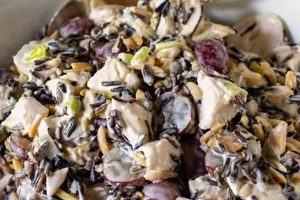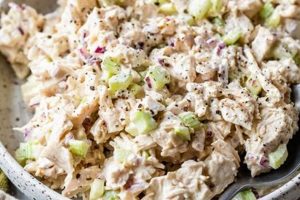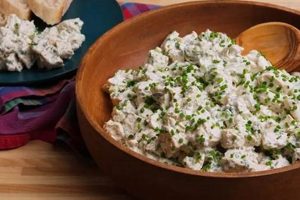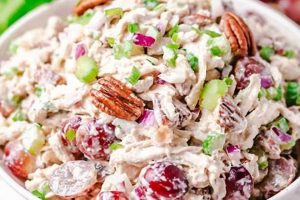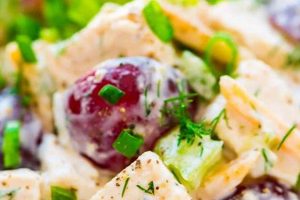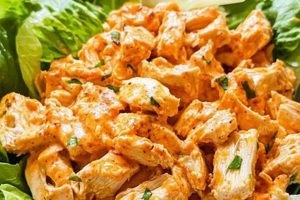A dish combining cooked chicken, jalapenos, and other ingredients often includes mayonnaise, celery, onion, and seasonings. Variations can incorporate different cheeses, fruits, nuts, or yogurt for a lighter take. These mixtures are typically served cold, often on bread, crackers, lettuce cups, or as a filling for wraps or sandwiches.
This culinary creation offers a balance of flavors and textures: the savory chicken, the heat of the jalapeno, the creamy richness of mayonnaise, and the crunch of celery and onion. It provides a good source of protein and can be a relatively quick and easy meal to prepare. Its adaptability to diverse ingredients makes it suitable for various dietary needs and preferences. From picnics to potlucks, its versatility lends itself well to casual gatherings and makes it a popular choice.
The following sections will explore specific ingredient combinations, preparation methods, nutritional information, and serving suggestions to assist in crafting the perfect version of this popular dish.
Tips for Creating a Delicious Jalapeno Chicken Salad
Achieving a well-balanced and flavorful dish requires attention to detail and an understanding of the interplay between ingredients. These tips offer guidance for optimizing flavor profiles and textures.
Tip 1: Control Heat Levels: Remove jalapeno seeds and membranes for a milder flavor. For increased heat, finely mince or leave some seeds intact. Taste-testing during preparation is recommended.
Tip 2: Chicken Selection: Rotisserie chicken offers convenience, while poached or grilled chicken breasts provide a leaner option. Ensure chicken is cooled completely before combining with other ingredients.
Tip 3: Texture Enhancement: Incorporating diced celery, red onion, or water chestnuts adds satisfying crunch. Toasted nuts, such as pecans or walnuts, can further enhance textural complexity.
Tip 4: Flavor Balancing: A touch of sweetness can complement the heat of jalapenos. Consider adding finely diced apples, grapes, or dried cranberries.
Tip 5: Mayonnaise Alternatives: Greek yogurt or avocado can replace mayonnaise for a lighter, healthier option. These substitutions can also impact overall flavor profiles.
Tip 6: Seasoning Considerations: Fresh herbs, such as cilantro or chives, can elevate the flavor profile. Ground cumin, smoked paprika, or garlic powder offer additional seasoning options.
Tip 7: Chilling Time: Allowing the mixture to chill for at least 30 minutes allows flavors to meld. Chilling also firms the salad, making it easier to handle for serving.
By following these tips, one can create a jalapeno chicken salad that offers a delicious balance of flavors, textures, and heat levels, tailored to individual preferences.
These guidelines offer a solid foundation for crafting a successful dish. Experimentation and adaptation to personal preferences are encouraged.
1. Ingredients
Ingredient selection directly impacts the final flavor profile, texture, and overall quality of a jalapeno chicken salad. Each component contributes specific characteristics, creating a complex interplay of tastes and sensations. The core ingredients typically include cooked chicken, jalapenos, and a binding agent such as mayonnaise. Beyond these foundational elements, a wide array of supplementary ingredients allows for customization and creativity.
For example, the type of chicken used influences the overall richness and texture. Shredded rotisserie chicken offers convenience and a robust flavor, while diced grilled chicken breast provides a leaner, milder option. Jalapeno quantity and preparation affect the level of heat. Removing seeds and membranes reduces spiciness, while finely mincing jalapenos intensifies their presence. The choice of binding agent also plays a significant role. Traditional mayonnaise contributes a creamy richness, while Greek yogurt offers a tangier, lighter alternative. Further additions, such as celery, red onion, grapes, or nuts, introduce textural contrasts and nuanced flavors.
Understanding the role of each ingredient allows for strategic choices based on desired outcomes. Careful consideration of ingredient combinations enables the creation of a balanced and satisfying dish. Whether aiming for a spicy, creamy, or tangy result, ingredient selection remains crucial. This understanding empowers culinary experimentation and adaptation to individual preferences, resulting in a truly personalized and enjoyable experience.
2. Preparation
Preparation significantly influences the final outcome of a jalapeno chicken salad recipe. It encompasses several crucial steps, from ingredient selection and handling to the order of combination and chilling time. Each stage affects the overall flavor, texture, and food safety of the dish. For instance, properly dicing ingredients ensures even distribution of flavors and prevents large chunks of any single component. The method of cooking chickenroasting, grilling, or poachingimparts distinct flavor profiles. Similarly, the handling of jalapenos dictates the level of heat. Removing seeds and membranes moderates the spiciness, while leaving them intact increases intensity. Furthermore, the order of combining ingredients impacts the emulsification and binding of the salad. Adding mayonnaise gradually while mixing ensures a smooth and creamy consistency. Finally, adequate chilling time allows the flavors to meld and enhances the overall experience.
Consider the effect of chopping versus shredding chicken. Chopped chicken creates a cleaner, more uniform texture, whereas shredded chicken offers a more rustic and textured feel. Similarly, the size of diced vegetables influences the sensory experience. Larger pieces offer more pronounced bursts of flavor and texture, while finely diced vegetables create a more homogenous blend. The choice between fresh and pre-ground spices also affects the overall flavor profile. Freshly ground spices offer a more vibrant and intense taste compared to their pre-ground counterparts. Moreover, observing safe food handling practices during preparation is paramount. Thoroughly washing produce and ensuring chicken reaches a safe internal temperature prevents bacterial contamination and ensures food safety.
Careful preparation is thus indispensable to a successful jalapeno chicken salad recipe. Attention to detail in each step, from ingredient selection to chilling, ultimately determines the final product’s quality and enjoyment. Understanding these nuances allows for greater control over the flavor profile, texture, and overall satisfaction derived from this versatile dish. Negligence in preparation can lead to imbalances in flavor, uneven textures, and potential food safety risks. Therefore, meticulous preparation is not merely a procedural step but a crucial element in achieving a delicious and safe culinary experience.
3. Spice Level
Spice level stands as a defining characteristic within any jalapeno chicken salad recipe. The inherent heat of jalapenos, derived from capsaicin, dictates the overall sensory experience. This heat can be modulated through various preparation techniques, allowing for a spectrum of spice levels ranging from mild to fiery. Understanding the relationship between jalapeno preparation and resultant heat is crucial for tailoring the recipe to individual preferences. For instance, removing the seeds and membranes significantly reduces the heat, yielding a milder salad. Conversely, incorporating finely chopped jalapenos, including seeds and membranes, intensifies the heat, creating a more fiery experience. Further influencing factors include the variety of jalapeno used, as some cultivars possess higher capsaicin concentrations than others. Quantity also plays a direct role; more jalapenos naturally translate to a spicier salad. The interplay of these factors allows for precise control over the final spice level.
Consider a scenario where a milder flavor profile is desired. Removing the seeds and membranes prior to incorporating the jalapenos into the salad reduces the capsaicin content, thereby lessening the heat. This method allows individuals sensitive to spice to enjoy the dish without discomfort. Conversely, those seeking a more intense heat experience might opt to include finely minced jalapenos, seeds intact. This approach maximizes capsaicin exposure, delivering a fiery kick. Beyond these fundamental techniques, additional ingredients can further influence the perceived heat. Dairy products, such as sour cream or yogurt, can help neutralize capsaicin, mitigating the spiciness. Conversely, acidic ingredients, like vinegar or lime juice, can heighten the perception of heat. These nuances highlight the complex relationship between ingredients and spice level.
Spice level thus offers a significant degree of customization within a jalapeno chicken salad recipe. Careful consideration of jalapeno preparation, quantity, variety, and interaction with other ingredients allows for precise tailoring of the heat intensity. This understanding empowers individuals to create a dish perfectly suited to their palates, ranging from mildly piquant to intensely fiery. Mastering spice level control is essential for achieving a balanced and enjoyable culinary experience, showcasing the versatility of this popular dish.
4. Serving Options
Serving options represent a crucial aspect of the jalapeno chicken salad experience, influencing both presentation and enjoyment. The versatility of this dish lends itself to a variety of formats, each offering unique advantages and catering to different occasions and preferences. Understanding these options allows for a more comprehensive appreciation of the dish’s adaptability and potential.
- Bread-Based Options:
Sandwiches, wraps, and sliders provide convenient and portable formats. The choice of bread influences the overall flavor profile and texture. Croissants offer a buttery richness, while whole-wheat bread provides a more nutritious option. Wraps, using tortillas or flatbreads, offer a lighter alternative. Miniature slider buns cater to smaller portions and appetizers.
- Salad Applications:
Jalapeno chicken salad can serve as a standalone salad, often incorporating leafy greens, tomatoes, cucumbers, and other vegetables. It can also function as a component within larger, more complex salads. For example, it pairs well with a bed of mixed greens, avocado slices, and a light vinaigrette. This approach offers a lighter and more refreshing presentation.
- Crackers and Dippers:
Serving the salad with crackers, pita chips, or vegetable sticks offers a casual and shareable format. This option is well-suited for parties and gatherings. The variety of dippers provides textural contrast and allows guests to customize their experience. This approach emphasizes the salad as a dip or spread.
- Stuffed Presentations:
Utilizing jalapeno chicken salad as a filling for tomatoes, avocados, or bell peppers creates visually appealing and flavorful presentations. This method offers a more substantial and elegant serving option, suitable for luncheons or light dinners. The choice of vessel complements the salad’s flavors and adds another layer of texture and visual interest.
The chosen serving option influences the overall perception and enjoyment of jalapeno chicken salad. Whether presented as a simple sandwich, a vibrant salad, or an elegant stuffed appetizer, the versatility of this dish allows for adaptation to a wide range of occasions and preferences. Considering these options enables a more nuanced and creative approach to serving and enjoying this popular dish.
5. Flavor Balance
Flavor balance constitutes a critical element in a successful jalapeno chicken salad recipe. It represents the harmonious interplay of different taste profilesprimarily spicy, creamy, savory, and acidiccreating a complex and satisfying culinary experience. A well-balanced salad avoids dominance by any single flavor, allowing each component to contribute to the overall profile without overpowering the others. Understanding the principles of flavor balance enables the creation of a dish that is both nuanced and enjoyable.
- Spice from Jalapenos
Jalapenos contribute the characteristic heat, a defining feature of this salad. The level of spice must be carefully calibrated to avoid overwhelming other flavors. Techniques such as removing seeds and membranes moderate the heat, while incorporating finely minced jalapenos intensifies it. Balancing this spice requires the strategic inclusion of other ingredients.
- Creaminess and Richness
Mayonnaise, Greek yogurt, or avocado provide creaminess and richness, which temper the jalapeno’s heat. The chosen ingredient influences the overall texture and flavor profile. Mayonnaise contributes a traditional richness, while Greek yogurt adds a tangy element. Avocado offers a healthy alternative with a distinct, smooth texture. This creaminess acts as a counterpoint to the spiciness.
- Savory Base of Chicken
Cooked chicken forms the foundation of the salad, providing a savory backdrop against which other flavors interact. The chicken’s preparation methodroasting, grilling, or poachinginfluences its inherent flavor profile. Rotisserie chicken imparts a richer, more complex flavor, while poached chicken offers a cleaner, milder taste. This savory element anchors the overall flavor profile.
- Acidity as a Brightener
Ingredients such as lime juice, vinegar, or chopped pickles introduce acidity, which brightens the overall flavor profile and cuts through the richness of the mayonnaise or other creamy components. This acidic element adds a layer of complexity and prevents the salad from becoming overly heavy or cloying. The type of acid used influences the final flavor; lime juice offers a citrusy brightness, while vinegar provides a sharper tang.
The interplay of these four elementsspice, creaminess, savoriness, and aciditydetermines the overall flavor balance of the jalapeno chicken salad. Achieving harmony between these components is crucial for a successful recipe. A dish lacking balance might be overly spicy, excessively creamy, or bland. By understanding the role of each element and employing techniques to modulate their intensity, one can create a jalapeno chicken salad that offers a complex, nuanced, and ultimately satisfying flavor experience.
6. Texture
Texture represents a crucial dimension of the jalapeno chicken salad experience, significantly impacting enjoyment and overall satisfaction. It refers to the tactile sensation experienced when consuming the salad, encompassing a range of qualities from creamy and smooth to crunchy and crisp. The interplay of these textural elements creates a dynamic and engaging sensory experience. A successful recipe carefully considers and balances these textures to achieve a harmonious and satisfying result.
Several ingredients contribute to the overall textural profile. The chicken itself, whether shredded or diced, provides a foundational texture. Shredded chicken offers a more fibrous and textured mouthfeel, while diced chicken presents a cleaner, more uniform texture. The choice of binding agent also plays a crucial role. Mayonnaise contributes a characteristic creaminess, while Greek yogurt offers a slightly tangier and less dense texture. Beyond these core components, the inclusion of vegetables and other additions further diversifies the textural landscape. Diced celery and red onion introduce crispness and a satisfying crunch, while ingredients like grapes or dried cranberries offer bursts of juiciness and chewiness. Nuts, such as pecans or walnuts, provide a contrasting crunch and a richer mouthfeel. The size to which these ingredients are chopped also influences the perceived texture; larger pieces create more pronounced textural contrasts, while finely diced ingredients contribute to a smoother, more homogenous blend.
Understanding the interplay of these textural elements is crucial for creating a well-balanced and enjoyable jalapeno chicken salad. A salad lacking textural variation might be perceived as monotonous or bland, while an excess of crunch could be overwhelming. Achieving a harmonious balance between creamy, crunchy, and juicy elements enhances the overall sensory experience and elevates the dish from simple to satisfying. This understanding allows for strategic ingredient selection and preparation techniques to tailor the texture to specific preferences, ensuring a delightful culinary experience.
7. Freshness
Freshness represents a critical factor influencing the quality, flavor, and safety of a jalapeno chicken salad recipe. Ingredient quality directly impacts the overall sensory experience and nutritional value. From the chicken and jalapenos to the supplementary components, freshness ensures optimal taste, texture, and food safety. Prioritizing fresh ingredients elevates this dish from simple to exceptional.
- Chicken Quality
Freshly cooked or rotisserie chicken contributes optimal flavor and texture. Avoiding pre-cooked or processed chicken, which can have a compromised flavor profile and texture, is recommended. Using high-quality chicken ensures the salad’s foundation remains flavorful and palatable.
- Jalapeno Vibrancy
Fresh jalapenos offer a crisp texture and vibrant flavor. Their appearance should be firm and unblemished, free from soft spots or discoloration. Fresh jalapenos provide the desired heat and contribute to the salad’s overall freshness.
- Produce Selection
Fresh produce, such as celery, red onion, and any other included vegetables or fruits, adds crucial textural and flavor components. Wilted or spoiled produce negatively impacts both taste and visual appeal. Selecting crisp, vibrant produce enhances the salad’s overall quality and freshness.
- Herb and Spice Impact
Fresh herbs and spices, when included, amplify the flavor profile. Dried herbs and spices can lose potency over time. Freshly ground spices and chopped herbs deliver a more vibrant and nuanced flavor. This attention to freshness elevates the overall sensory experience.
Prioritizing freshness in every component of a jalapeno chicken salad recipe significantly impacts the final product. From the core ingredients to the supplementary additions, freshness ensures optimal flavor, texture, and food safety. This dedication to quality elevates the dish, transforming it from a simple combination of ingredients into a vibrant and satisfying culinary experience. Neglecting freshness compromises the overall quality and enjoyment, underscoring its importance in achieving a truly successful outcome.
Frequently Asked Questions
This section addresses common inquiries regarding jalapeno chicken salad recipes, offering concise and informative responses to facilitate a deeper understanding of preparation, variations, and storage.
Question 1: How can spice levels be adjusted?
Spice level modification is achieved primarily through jalapeno preparation. Removing seeds and membranes significantly reduces heat. Conversely, incorporating finely chopped jalapenos, including seeds, increases spiciness. The quantity of jalapenos used also directly correlates to the final heat level.
Question 2: What are suitable mayonnaise alternatives?
Greek yogurt or mashed avocado provide healthier alternatives to mayonnaise, offering distinct flavor profiles and reduced fat content. These substitutes impact the salad’s overall texture and taste.
Question 3: How long can this salad be stored?
Properly stored in an airtight container within a refrigerator, jalapeno chicken salad typically remains safe for consumption up to three to four days. Spoilage signs include off-odors or discoloration.
Question 4: Can canned chicken be used?
While canned chicken offers convenience, freshly cooked or rotisserie chicken delivers superior flavor and texture. Canned chicken tends to possess a different texture and may impart a slightly metallic taste.
Question 5: What are suitable serving options beyond sandwiches?
Serving options extend beyond sandwiches to include lettuce wraps, stuffed avocados or tomatoes, atop crackers, or as a component within a larger salad composition. These variations enhance versatility.
Question 6: How can the salad’s texture be enhanced?
Incorporating elements like chopped celery, red onion, water chestnuts, or toasted nuts introduces textural variety, offering contrasting crunch and enhancing the overall sensory experience.
Careful consideration of these frequently asked questions facilitates a comprehensive understanding of jalapeno chicken salad preparation and enjoyment. These insights empower culinary exploration and customization.
The following section provides a sample recipe incorporating the principles discussed throughout this article.
Jalapeno Chicken Salad Recipe
This exploration of jalapeno chicken salad recipes has delved into the multifaceted aspects of this versatile dish. From ingredient selection and preparation techniques to spice level adjustments and serving options, the potential for customization and creative expression is evident. The importance of freshness, flavor balance, and textural variation in achieving a satisfying culinary outcome has been underscored. Key considerations include the careful handling of jalapenos to control heat, the strategic selection of complementary ingredients to achieve flavor harmony, and the incorporation of textural elements to create a dynamic sensory experience.
Culinary enthusiasts are encouraged to experiment with the discussed principles and techniques to craft personalized versions of this classic dish. Adaptation to individual preferences and dietary needs ensures a satisfying and enjoyable experience. The continued exploration of flavor profiles and creative presentation methods promises a vibrant future for the jalapeno chicken salad recipe, solidifying its place as a culinary staple.

